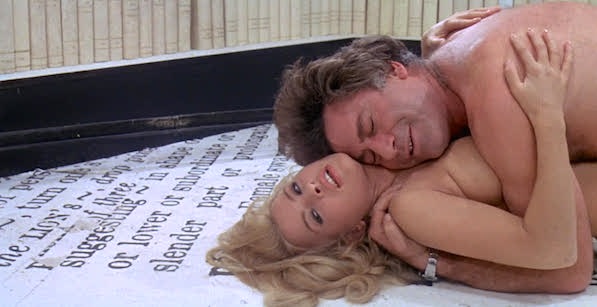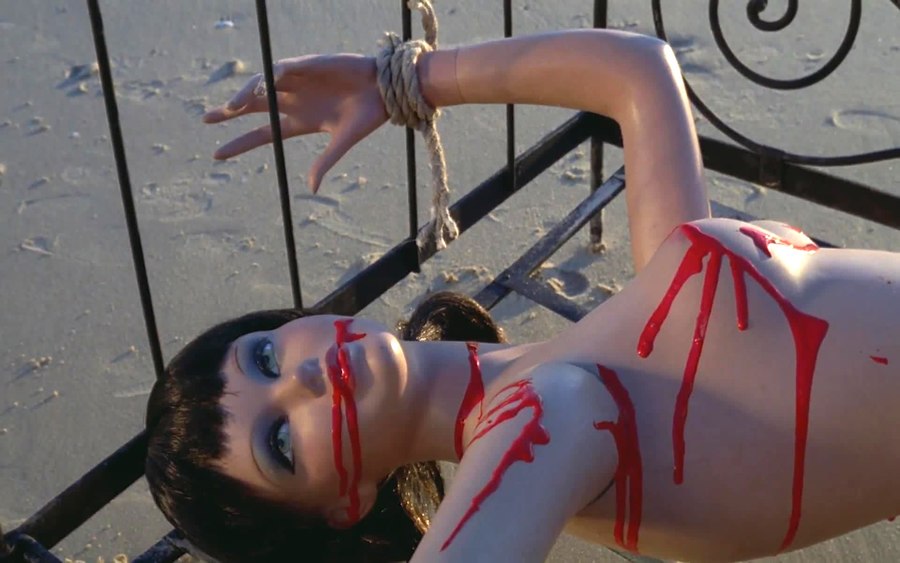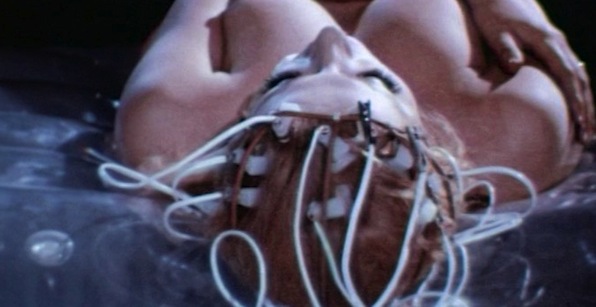
Sex sells, as the saying goes, and movie producers, distributors and exhibitors have known this since pictures began to move.
In That’s Sexploitation, filmmaker Frank Henenlotter and exploitation legend David Friedman celebrate the freewheeling culture of sexploitation, the sensationalistic underground of independent filmmakers and studios who cashed in on promises of carnal thrills and forbidden spectacle, specifically naked flesh (mostly female). These are the films that sprung up between the cracks of the production code and studio restrictions and, as the moniker suggests, they aimed straight for the lurid and the tawdry.
But not all films that sold themselves with the promise of erotic thrills and taboo-busting presentations of sexuality were a matter of pure exploitation. American movies started taking on adults themes once again in the fifties while films from the more permissive Europe blurred the lines between art and erotica as they explored sexuality with both a maturity and a more graphic explicitness. In other words, people got naked and shared bed right on the screen. “That’s not smut, that’s art,” was the implicit argument, even if it was the sex that the exhibitors marketed.
Here are ten films from the heady days of the sexual revolution to the present that smudge the line between art and exploitation. Sex may be the subject, the subtext, or the motivation, but promise of steamy spectacle and erotic delights was used attract patrons that normally might not otherwise attend such fare and give them the cinematic equivalent to the time-honored justification for purchasing Playboy magazine: “I get it for the articles.”
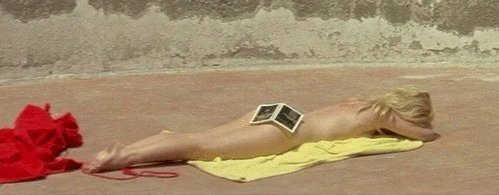
Contempt (Jean-Luc Godard, 1963)
Blow-Up (Michelangelo Antonioni, 1966)
Here are two examples of marketing skin to attract audiences to challenging films from European intellectual filmmakers. Contempt (1963) is an unlikely meeting between nouvelle vague legend Jean-Luc Godard’s anti-Hollywood sensibility and the showman aesthetic of (uncredited) producer Joseph E. Levine in an international co-production about the clash between art and commerce, the politics of artistic integrity and compromise and the dissolution of love. To meet his producer’s demands, Godard added an opening bedroom scene and inserted pin-up style nude shots of star Brigitte Bardot. Wouldn’t you know he actually makes them work as a comment on the very process of filmmaking compromise? Blow-Up (1966), the English-language debut of Italian filmmaker Michelangelo Antonioni, is an existential murder mystery starring David Hemmings as a jaded fashion photographer who may have taken a picture of murder and Vanessa Redgrave as the mystery woman of his photograph. Set in swinging London, full of mod fashions, free love, a score by Herbie Hancock and an appearance by the Yardbirds, it’s a timepiece by way of Antonioni’s brand of contemporary alienation and it won the Palme d’Or at Cannes. It was also the first mainstream movie to show female pubic hair (however fleetingly) and that was a bigger selling point for a lot of the patrons.
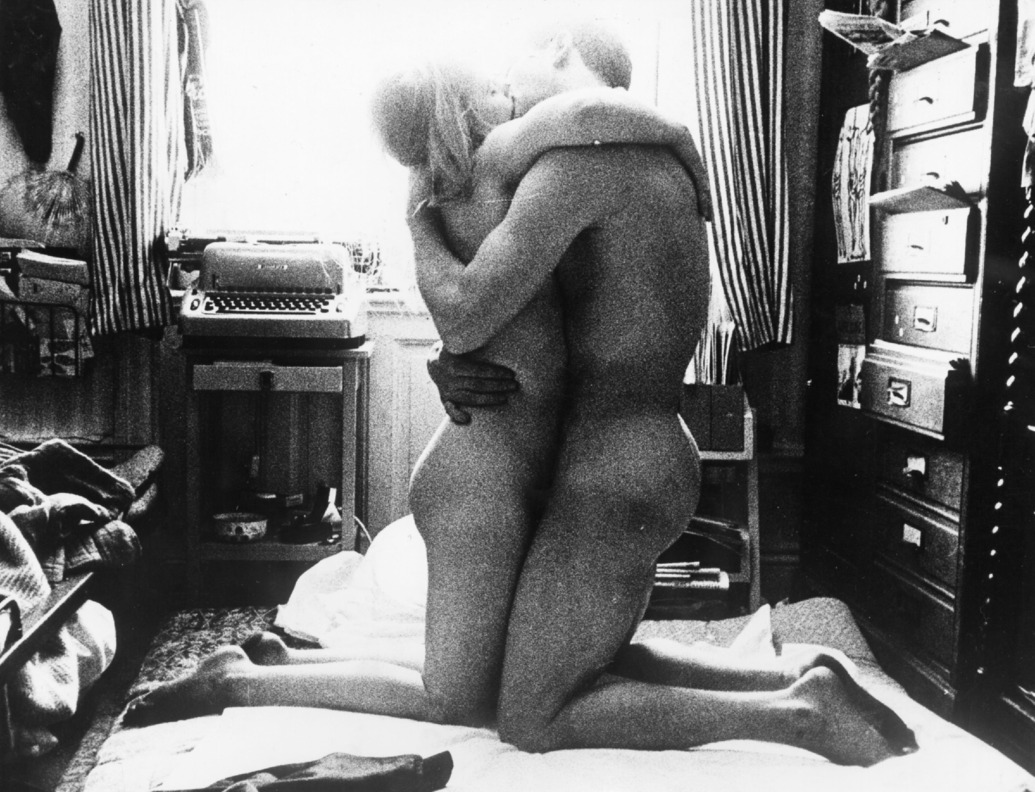
I Am Curious: Yellow (Vilgot Sjoman, 1967)
Vilgot Sjoman’s arthouse dramas of politics, society and the sexual revolution in late 1960s Sweden stars Lena Nyman as a 20 year old young woman on a journey of self-discovery. It became a sensation when it was confiscated by customs officials, banned in Massachusetts and branded “obscene” for its unprecedented display of full frontal nudity, simulated sexual contact and (most shockingly) Lena’s lips kissing her lover’s penis. In fact, the free-form mix of fiction and documentary proved a disappointment to audiences who came strictly to glimpse its notorious nudity, but it fit right in to the anything-goes spirit of the French New Wave. It became a huge hit, the most successful foreign import ever to that time. The follow-up, I Am Curious: Blue (1968), continues the story of Lena and her equally curious boyfriend (Borje Ahlstedt), but it’s not so much a sequel as a companion piece, shot almost simultaneously with the first film. Together, the colors make up the Swedish flag.
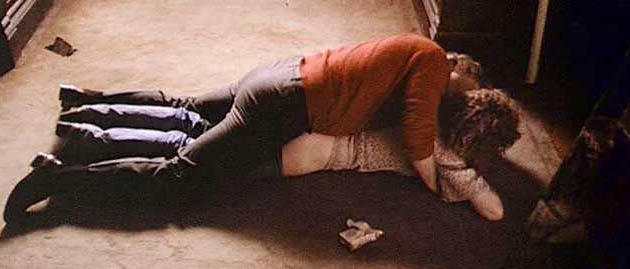
Last Tango in Paris (Bernardo Bertolucci, 1972)
Bernardo Bertolucci’s Last Tango in Paris is the summit of eroticism as subject, theme and counterpoint in the cinema. Rated X upon its original release for its frank and notorious sex scenes (since re-rated NC-17), it stars Marlon Brando at the height of his fame and his talent as a 45-year-old American widower who escapes his anger and despair after his wife’s suicide in a purely physical relationship with a free-spirited young beauty (Maria Schneider). Brando delivers a raw, emotionally naked performance; there is more anguish and desperation in his opening shots than most actors can muster in a complete feature. Schneider made her fame as the voluptuous, optimistic youth fascinated by this enigmatic American who insists on no names and no life histories. The portrait of a sadomasochistic, purely carnal relationship challenged taboos of sexual politics and on-screen sexuality and it received Academy Award nominations for both Brando’s performance and Bertolucci’s direction. It was the most sexually explicit film to receive such a stamp of critical respectability in its day. As a footnote, Catherine Breillat, who would explore sexuality with a similar daring as a director in her own right, has a small role in the film.
The Lickerish Quartet (Radley Metzger, 1970)
Where Bertolucci came to sexual subject matter from a respected career making politically-charged films, Radley Metzger began his career importing sexy European imports for American distribution and making erotic films with ambitions to arthouse respectability. Therese and Isabelle (1968) announced Metzger’s aspirations but The Lickerish Quartet was his first to be branded with the X-rating (even though it features no explicit or hardcore footage) for nudity and sexuality. The story of a family of jaded aristocrats who go slumming at a carnival and come home with the shapely blond daredevil cyclist is also his most conceptually ambitious and intellectually challenging film and, by his own admission, his most personal. You could describe this delirious erotic fantasy as a stag film reworking of Teorema as directed by Alain Resnais, filled with flashbacks, fantasies, shifts of perspective and even identity. Score (1973) is even more visually elegant and frank in its sexuality, but The Lickerish Quartet is his most spellbinding erotic romp as European art movie: playful, smart, ripe, sensuous and very, very sexy.
Successive Slidings of Pleasure (Alain Robbe-Grillet, 1974)
And speaking of Alain Resnais, the Last Year at Marienbad screenwriter and celebrated nouvelle roman author Alain Robbe-Grillet became a filmmaker in his own right after his collaboration with Resnais, making movies that stirred storytelling experiments with erotic imagery and kinky sexuality. He made his debut with L’Immortelle (1963) and had his greatest popular success with the playful yet narratively heady Trans-Europ-Express (1966), but Successive Slidings of Pleasure takes sexual fantasy to heady levels. Ostensibly a murder mystery with an exhibitionist / conceptual artist suspect (Anicée Alvina, mostly unclothed), a surrealist of a detective playing private eye (Jean-Louis Trintignant, making little more than a cameo), a convent with a sex dungeon, a mother superior who personally metes out corporeal punishment on the naked skin of her female prisoners, and a judge (Michael Lonsdale) lost in his own words, it’s like the love child of Jean-Luc Godard and Jean Rollin. Call it post-modern erotica, where the pleasures are cerebral and conceptual…with a lot of sex in it.
Attraction (Tinto Brass, 1969)
Tinto Brass is remembered today (when he’s remembered at all) as the director of Caligula, the notorious and grotesque X-rated Roman epic produced by Penthouse magazine publisher Bob Guccione (who added explicit footage into the already sleazy spectacle), and as the auteur of a string of lighthearted erotic romps inspired by classic literature. But before he walked that line between class and crass as a leading Eurotica filmmaker, Brass was more interested in nouvelle vague and nudity. The two came together most effectively in Attraction (aka Nerosubianco, 1969), his stroll through the sexual revolution presented as a succession of surreal erotic daydreams of a married woman on a lazy stroll on a sunny London afternoon. A self-styled “Psychedelic Pop Art Experience” (as the poster promises) with stabs of erotic fantasy and sixties politics, it’s like a rock and roll art film by way of a continental skin flick, with pop art posters and Guido Crepax comics interspersed with a newsreel clips of Vietnam and the Holocaust to give it progressive political cred.
Requiem for a Vampire (1971) and the films of Jean Rollin
Jean Rollin was decidedly in the trenches of exploitation cinema—he made low-budget horror films filled with nudity and sex—and by almost any measure he would not be considered in the same company as the filmmakers on this list. I posit that his films are ostensibly sexploitation but aspire to art. Imagine the poetry of Jean Cocteau meeting the emotionless performances of Robert Bresson, shot on starvation budgets and rushed shooting schedules with porn stars taking the leads. To pluck one standout from his filmography, I nominate Requiem for a Vampire, which opens with two nymphets in clown garb blasting handguns from the back of a getaway car, sends them dreamily wandering through a graveyard and ends up in a castle where tired, sorry looking vampire attempts to perpetuate his race with fresh blood. Fairy tale imagery, surreal poetry and eerie beauty gives way to astonishingly brutal scenes of kinky decadence and brutal nastiness, but Rollin’s ethereal mood gives the largely wordless film a strange delicacy. But that same mix of B-movie exploitation by way of an avant-garde eroticism with the screwy logic of a waking dream can be found in Shiver of the Vampires (1971), The Iron Rose (1973), Lips of Blood (1975) and Night of the Hunted (1980). Rollin is the erotic poet of le cinema fantastique.
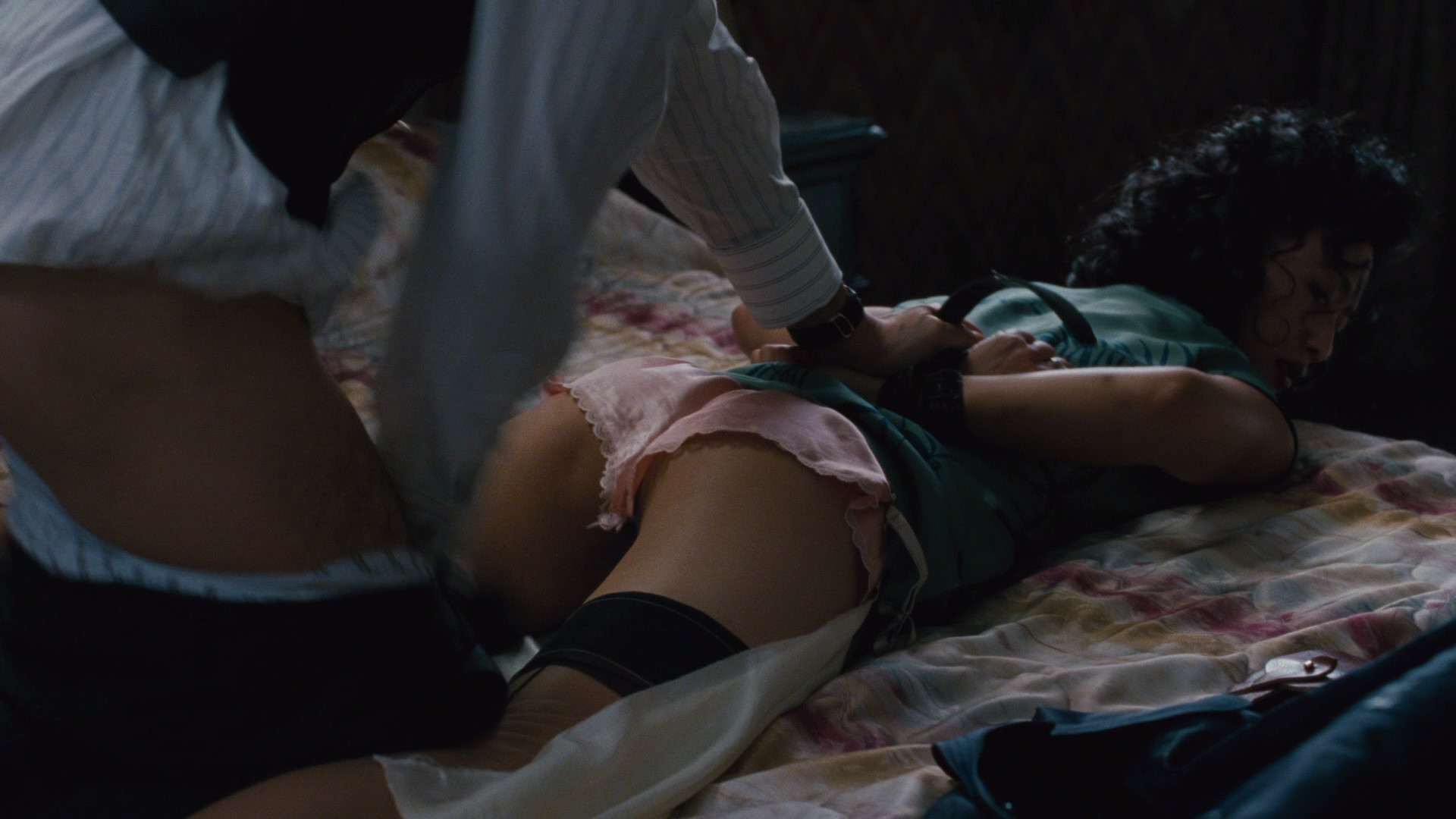
Lust, Caution (Ang Lee, 2007)
Back in the elevated world of art cinema we come to Ang Lee, the Taiwan-born, American-trained filmmaker who has pushed boundaries in both countries when it comes to breaking sexual taboos. There is far more caution than lust in his tastefully erotic espionage thriller Lust, Caution, at least in the first half of the film. But then what would you expect from a director whose career is defined by characters who either repress their true feelings out of cultural expectation or social shame, or mask their emotions with manners and rituals. The lust is so inextricably caught up, and in some ways compounded, by the caution that when Lee (Tony Leung Chiu Wai), a collaborator working for the Japanese in occupied Shanghai during World War II, finally consummates his affair with Wang Jiazhi (Tang Wei), a young actress turned agent for the resistance, the stillness of restraint snaps like a dry twig and he explodes like a wild animal. The explicit coital scenes of bodies pumping away in brutal and animalistic sex is a shock to the elegant stillness and tasteful restraint of Lee, who even shoots squalor with grace and beauty, but it’s also a force that overwhelms and confuses the emotional balance of the young woman. The scenes earned the film an NC-17 rating in the U.S. and were outright censored in China and India.
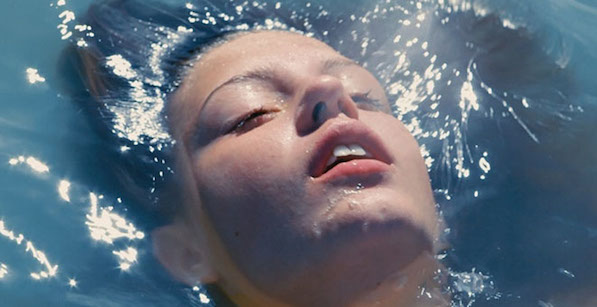
Blue is the Warmest Color (Abdellatif Kechiche, 2013)
A provocative and emotionally intimate drama about a romance between two young women, Blue is the Warmest Color won the Palme d’Or at Cannes and its two stars, Adèle Exarchopoulos and Léa Seydoux, shared the Best Actress prize. Then it became the center of furious critic tug-of-war for months after when its male director, Abdellatif Kechiche, was accused of exploiting the actresses in a graphic (though not explicit) scene of lovemaking and misrepresenting the relations between two women in love. It unfortunately distracted the conversation from what the film is actually about: first love, overpowering desire, the excitement of discovering yourself and the fear of what others may think of you. The sexuality is provocative but this is no peep show. It’s about letting all boundaries go and giving in to desire and pleasure, devouring another and being devoured, and it shows the gap between her potential and her fear of embracing her identity and her love in front of the world. As the original French title of the film, La vie d’Adèle: Chapters 1 & 2, suggests, Adèle is a work in progress. Kechiche explores her stumbles on the way to finding herself.

